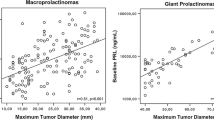Abstract
In men harboring prolactinoma the most common symptoms are related to hypogonadism, including decreased libido, erectile dysfunction, and gynecomastia. These men characteristically present with elevated serum prolactin (PRL) levels, suppressed gonadotropins, and low testosterone levels. We studied a group of 11 unique men with prolactinomas presenting with testosterone levels within the normal range (≥2.6 ng/ml; cohort A), and compared them to 11 prolactinoma men with borderline baseline testosterone (2.1–2.5 ng/ml; cohort B) and to a cohort of 34 prolactinoma patients with low testosterone levels (≤2 ng/ml; cohort C). Mean testosterone levels at presentation were 3.91 ± 0.9 ng/ml in cohort A (range, 2.6–5.2 ng/ml), 2.44 ± 0.16 ng/ml in cohort B and 0.96 ± 0.6 in cohort C (p < 0.001). Mean baseline PRL levels were >20 times above normal in cohort A compared to >100 times above normal in cohorts B and C. Symptoms of hypogonadism were present in 55, 64 and 76 % of men in groups A, B and C, respectively. There was a trend towards a larger tumor size in the low testosterone group (p = 0.06). Visual fields defects at presentation were more prevalent in this cohort (C). With cabergoline, testosterone level increased from 3.91 to 6.42 ng/ml (Δ = 2.51 ng/ml) in cohort A, from 2.44 to 5.63 ng/ml (Δ = 3.19 ng/ml) in cohort B, and from 0.96 to 3.30 ng/ml (Δ = 2.34 ng/ml) in cohort C (p < 0.05 for each group). Symptoms of hypogonadism improved following treatment in 83 % of symptomatic men in cohort A. Normal testosterone does not exclude the likelihood of prolactinoma in men. When treated with cabergoline, testosterone levels in these men can increase higher within the normal range together with clinical improvement.


Similar content being viewed by others
References
Ciccarelli A, Guerra E, De Rosa M, Milone F, Zarrilli S, Lombardi G, Colao A (2005) PRL secreting adenomas in male patients. Pituitary 8:39–42
De Rosa M, Zarrilli S, Di Sarno A, Milano N, Gaccione M, Boggia B, Lombardi G, Colao A (2003) Hyperprolactinemia in men: clinical and biochemical features and response to treatment. Endocrine 20:75–82
Shimon I, Benbassat C, Tzvetov G, Grozinsky-Glasberg S (2011) Anemia in a cohort of men with macroprolactinomas: increase in hemoglobin levels follows prolactin suppression. Pituitary 14:11–15
Colao A, Di Sarno A, Guerra E, De Leo M, Mentone A, Lombardi G (2006) Drug insight: cabergoline and bromocriptine in the treatment of hyperprolactinemia in men and women. Nat Clin Pract Endocrinol Metab 2:200–210
Gillman MP, Molitch ME, Lombardi G, Colao A (2006) Advances in the treatment of prolactinomas. Endocr Rev 27:485–534
Pinzone JJ, Katznelson L, Danila DC, Pauler DK, Miller CS, Klibanski A (2000) Primary medical therapy of micro- and macroprolactinomas in men. J Clin Endocrinol Metab 85:3053–3057
Colao A, Vitale G, Cappabianca P, Briganti F, Ciccarelli A, De Rosa M, Zarrilli S, Lombardo G (2004) Outcome of cabergoline treatment in men with prolactinoma: effect of a 24-month treatment on prolactin levels, tumor mass, recovery of pituitary function, and semen analysis. J Clin Endocrinol Metab 89:1704–1711
Shimon I, Benbassat C, Hadani M (2007) Effectiveness of long-term cabergoline treatment for giant prolactinomas: study of 12 men. Eur J Endocrinol 156:225–231
Berezin M, Shimon I, Hadani M (1995) Prolactinoma in 53 men: clinical characteristics and modes of treatment (male prolactinoma). J Endocrinol Invest 18:436–441
Naliato EC, Farias ML, Braucks GR, Costa FS, Zylberberg D, Violante AH (2005) Prevalence of osteopenia in men with prolactinoma. J Endocrinol Invest 28:12–17
Ono M, Miki N, Kawamata T, Makino R, Amano K, Seki T, Kubo O, Hori T, Takano K (2008) Prospective study of high-dose cabergoline treatment of prolactinomas in 150 patients. J Clin Endocrinol Metab 93:4721–4727
Iglesias P, Bernal C, Villabona C, Castro JC, Arrieta F, Díez JJ (2012) Prolactinomas in men: a multicentre and retrospective analysis of treatment outcome. Clin Endocrinol (Oxf) 77:281–287
Sibal L, Ugwu P, Kendall-Taylor P, Ball SG, James RA, Pearce SH, Hall K, Quinton R (2002) Medical therapy of macroprolactinomas in males: I. Prevalence of hypopituitarism at diagnosis. II. Proportion of cases exhibiting recovery of pituitary function. Pituitary 5:243–246
Elenkova CA, Genov N, Abadzhieva Z, Kirilov G, Vasilev V, Kalinov K, Zacharieva S (2013) Macroprolactinemia in patients with prolactinomas: prevalence and clinical significance. Exp Clin Endocrinol Diabetes 121:201–205
Tamer G, Telci A, Mert M, Uzum AK, Aral F, Tanakol R, Yarman S, Boztepe H, Colak N, Alagöl F (2012) Prevalence of pituitary adenomas in macroprolactinemic patients may be higher than it is presumed. Endocrine 41:138–143
Conflict of interest
The authors declare that they have no conflict of interest.
Author information
Authors and Affiliations
Corresponding author
Rights and permissions
About this article
Cite this article
Shimon, I., Benbassat, C. Male prolactinomas presenting with normal testosterone levels. Pituitary 17, 246–250 (2014). https://doi.org/10.1007/s11102-013-0497-x
Published:
Issue Date:
DOI: https://doi.org/10.1007/s11102-013-0497-x




